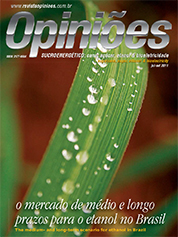Miguel Rubens Tranin
President of Alcopar
Op-AA-29
The outlook is optimistic, but one must do the homework
Analyzing the current world energy scenario, characterized by high oil prices, conflict in producer countries and insecurity generated by nuclear power plants, notably following the earthquake in Japan, we become even more optimistic about the future of the sugarcane-based industry in the country.
Experts do not doubt that oil prices will continue to be high, even if we soon have the availability of the Brazilian pre-salt layer oil reserves and those located in Antarctica.
Hence the current scenario is one that dictates strengthening ethanol, based on all its advantages and benefits, as well as the energy from the biomass co-generation system, while recalling that the raw material – sugarcane – is abundantly produced in several regions of Brazil, providing economic and social development.
One should bear in mind that both are leveraged mainly and preferentially by the Brazilian government (Petrobras and Bndes). In this respect, one should add that the continuity of “opportunities and incentives in organizing large groups” has allowed the modernization and financial strengthening of companies. With this industry thus strengthened, sugarcane producers feel safer when celebrating lease contracts.
Even with the growing production of grain, we still have large spaces available throughout the country, with poorer soil, which can be utilized, along with those currently being used, as low productivity grazing land.
It is along this route that the activity is expanding, without conflict in relation to the production of food, and supported by genetic and phytosanitary improvements. The 2011/2012 agricultural plan foresaw funds for the industry, whereas all it takes is to adapt such availability to producers’ actual needs.
On the other hand, the ANP (national oil, natural gas and biofuels agency) has shown professionalism, seeking to fully understand the industry.
Thus, it will surely set short- and medium-term policies for this economic segment. In this respect, we call attention to the fact that the process requires a plan, drawn up together with the government, to align proposals, whereas it is essential to encompass all participants of the chain that comprises producers-companies-distribution-retailing, each with its rights and obligations.
On the other hand, pipeline and road logistics stand out as highly relevant for establishing safe growth and supply, given that plantations are increasingly expanding in the country’s interior. For the medium- and long-term, surveys indicate chemical alternatives for ethanol and the full utilization of sugarcane, provided technologies reduce production costs, making them more competitive in relation to competing products.
As one can see, the outlook is very optimistic, but first one must do one’s homework, making sure to align the proposals of the government and the industry, the basis of continuous, stable and safe growth, while committing to such proposals.
On the other hand, one should not lose sight of the big differential of ethanol in relation to other fuels, particularly as related to the environment. Often enough, at the height of discussions about the product’s prices, we forget the advantages offered by the sugarcane-derived product, treating it as ordinary fuel.
Irrespective of issues viewed as merely eventual, such as price increases in recent months, ethanol has always been competitive. Evidence hereof is the popularity it has achieved, mainly during the last decade.
More important, however, is to have a reliable product obtained from a renewable source, whose impact on the environment is smaller in comparison with the damage caused by oil derivative products – an increasingly worrisome situation in light of growth in demand for transportation in the big cities.
Although the image of biofuel has been adversely affected by the issue related to ethanol produced from corn in the United States, one must take into consideration that the Brazilians are doing what they should do, by continuing to bet on ethanol obtained from sugarcane, while in the domestic market upholding high consumption levels.
More than consume ethanol, it is necessary that the consumer be aware of the fact that he or she is consuming the best fuel from the environmental perspective. If one should eventually discuss a price-related issue, this would certainly be a temporary situation which cannot overlap the objective for which it was created.
Like we said before, optimism about the future of ethanol in the country and in the world strengthens our belief that the sugarcane-based industry is headed towards a new phase in its history.
Taking the State of Paraná as an example, the activity is present in more than 140 of the 399 municipalities, in which it generates evident economic development, quality of life for the population directly and indirectly involved, and where it acts continuously and consistently in preserving the environment.
Thus, when a consumer fills up the tank with ethanol, he or she will be helping to turn a big wheel of fortune, along with players other than entrepreneurs, such as workers in the industry’s companies and in the fields, but also countless farmers and their families, suppliers of all sizes, researchers and society in general. Ethanol has the face of Brazil, and is reason of pride for all Brazilians.




